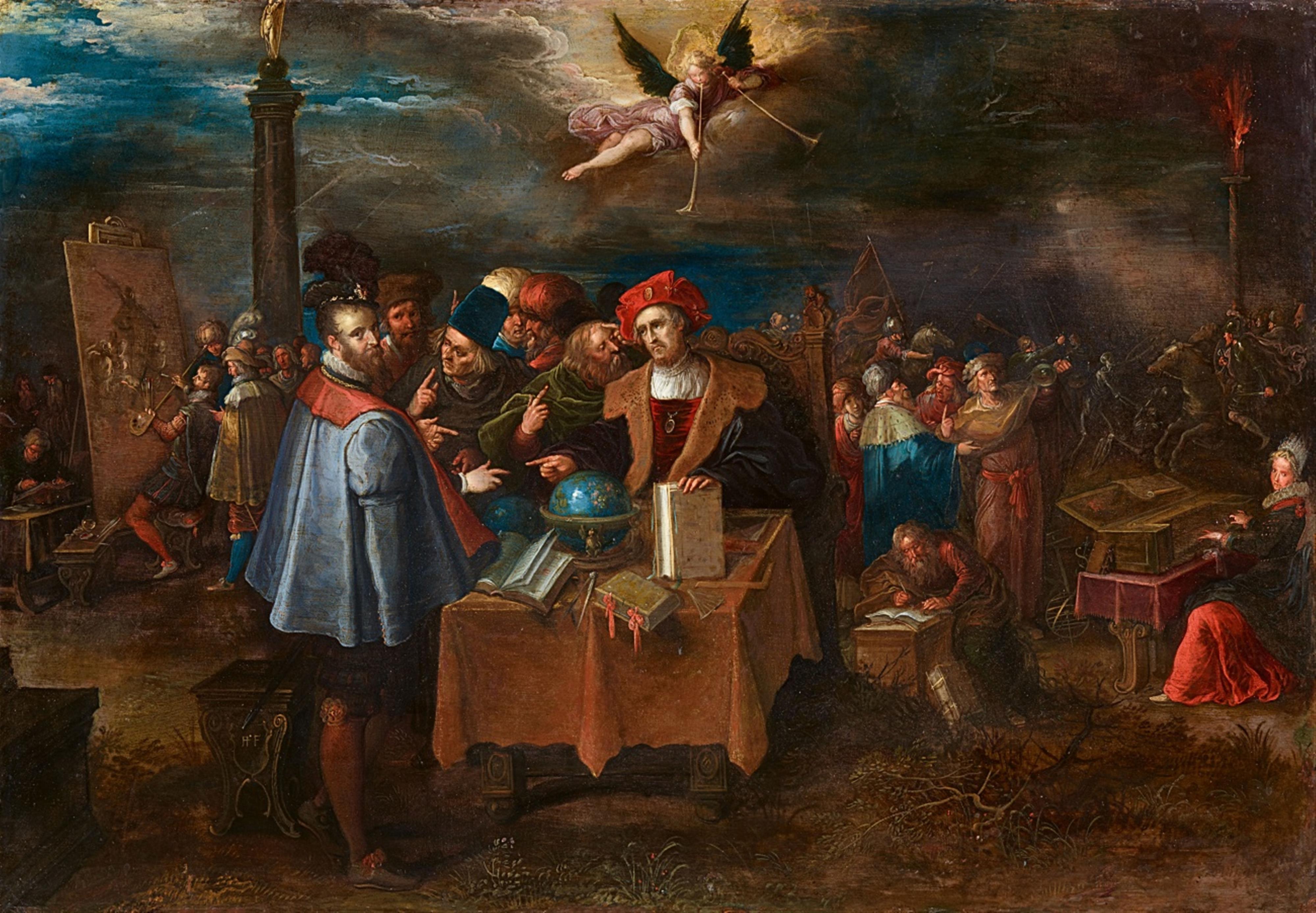Frans Francken the Younger
Various Methods of Achieving Fame
Oil on copper. 58 x 40.5 cm.
Monogrammed on the lower left: FF F (FF conjoined).
On the reverse the mark of Peeter Stas.
Various Methods of Achieving Fame - the unusual title of this composition, to be dated around 1611, can be derived from a work by Frans Francken the Younger which was sold at auction in the 18th century, the composition of which has survived in various versions (Härting 1989, op. cit., p. 353 - 354).
We see a nocturnal landscape in which numerous figures have gathered in groups. Fama, the personification of fame, glides through the sky above them, blowing her trumpet. Below her in the centre of the work, a group of men sit around a table, engaged in a lively discussion. The erudite nature of their debate can be ascertained from their gestures and the objects arranged upon the table before them: Books, globes depicting the earth and the sky, a pair of compasses, and a sundial. They are the symbols of the seven liberal arts, the ancient canon of Humanist education. When we allow our gaze to drift towards the left, we see an artist at his easel surrounded by onlookers discussing the unfinished painting. Behind him, a pillar with a golden statue at its summit rises up into the sky. We see further groups of figures in conversation scattered across the canvas. They are dressed in costumes from various historical eras, as might be seen in Frans Francken's works depicting the stories of the Old Testament or the ancient myths. On the right hand side of the image we see a battle scene and before it a female figure playing a spinet. She reminds us that the symbol of one of the liberal arts, music, is missing from the objects on the table and is instead represented in this personification.
“The preferred theme of this “lover's cabinet” is that of conversation. A dialogue structure permeates the entire depiction (…) What we are dealing with is a colloquium or disputatio, or, to use a phrase common at the time, with an entretien” (Victor Stoichita, The Self-Aware Image: An Insight Into Early Modern Meta-Painting, Cambridge 1997, p. 135). Stoichita's comment on the gallery paintings of Frans Francken can also be applied to the present work. It is a complex composition that contains numerous references both within its own motifs and to other paintings, including other works by Frans Francken, and allows for multiple layers of observation and interpretation.
The figures, for example, conversing around the table in the centre of the image appear to derive from Giorgio Vasari's ideal portrait of the “Seven Italian Writers”, that was reproduced in an engraving by Hieronymus Cock (cf. ill. 1). In contrast to other versions of this composition, here the scholars are placed in a prominent position. This version also differs greatly from others in that it is limited to the depiction of the arts and sciences, whereas other versions also include generals and rulers.
The painting on the easel is known from another work by Frans Francken, “Painting and Poetry (Ut Pictura Poesis)”, portraying Apoll and the Muses, symbolising the Inspiratio of the poet. The golden statue on the column represents the Allegory of Fortuna or Occasio, depicted by Francken in a number of famous allegorical paintings.
The subject of this painting is therefore the fame that can be achieved through the arts and sciences. Francken represents an ideal “community” of artists and scholars, but also their supporters and patrons, united in the creation of and the discussion of art. This interpretation becomes yet more fascinating when we take into account Ursula Härting's suggestion that the figure with the feathered hat looking out towards the viewer could be a self-portrait of the artist himself (cf. ill. 2). The figure is depicted looking over his shoulder, a pose typically used in self-portraits of that period. In this case it would be no coincidence that the artist's monogram “FF F” (“Frans Francken Fecit”) can be found on the stool from which the figure arises. If Härting's conclusion is correct, then the artist is present here in two roles: Both as the creator of a work of art representing artistic inspiration and as a participant in a scholarly discussion. The painting could thus be interpreted as a confident (self-)praise of artists, whose works - as was the case with those of Frans Francken - are based on an extensive education.
The work could also be viewed more broadly as Frans Francken praising the new flowering of Flemish painting initiated by the rising patronage of the governors of the Southern Netherlands, the Twelve Years´ Truce, and a young generation of artists. Thus, the dark of the night, which still almost entirely envelops the battle scene on the right, gradually subsides towards the left of the image where the artist is shown working at his easel surrounded by patrons. Fortuna (or Occasio) is the patron of this new era. This reading of the work is completed by the personification of music as the symbol of a new age of harmony overcoming the dark age of discord.
Literature
For the other version of the composition cf. Ursula Härting, Frans Francken der Jüngere (1581-1642). Die Gemälde mit kritischem Oeuvrekatalog. Freren 1989, p. 353-354.

